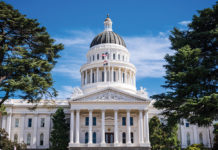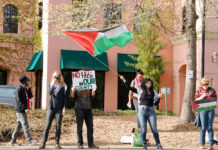The No on R signs with their ominous “Protect Healdsburg” byline remind me of the dad we met at the farmers’ market whose icebreaker question was “What do you do for work that you can live here?”— as though we belong to a special club and not a town. Or the guy in Parkland Farms who told me he wasn’t concerned about the Saggio Hills development because, “That’s all going to be high end stuff … What I’m worried about are the apartments they want to build downtown— it’ll look like Rohnert Park.”
The steady hollowing out of Healdsburg by wealth is not new, it’s just accelerating: when I was in high school, a local nonprofit proposed to build five units of deed restricted housing for public servants like teachers and firefighters around the corner from our house. They were totally shut down by neighbors who didn’t want their property values brought down. Just like the No on R literature, they used scare tactics about loss of charm, corruption and scarce resources.
They’ve sold their houses now, and where the affordable ones would have been are two giant, undeniably un-charming houses. You can rent the one no one lives in fully furnished by the month for $6,500. On our block alone, three former two-bedroom bungalows turned luxury getaways stand empty, their porch fans sometimes left on for months, their malfunctioning sprinklers spewing water onto the pavement for hours.
When my husband and I decided to start a family, we chose to move back to Healdsburg to be near my family (very near; we rent a one-room studio in my parent’s backyard, my brother and his girlfriend in the granny unit next door). Together we grow vegetables, collect rainwater, conserve energy, do the tough work of making collective decisions, work locally. But we knew, when we came here, that it would be temporary. The space is cramped with a toddler, and the down payment on houses here is totally out of reach. If we rent indefinitely, we perpetuate the inequality by competing with people who have less than we do for scarce rental options.
Since we’ve lived here, staying has become harder to imagine for less practical reasons as well; as much as I love it here, and would love for my son to live near his grandparents, I don’t want to raise him surrounded by wealthy white kids whose parents and neighbors have no interest in working together to solve real problems they would rather pay to avoid.
We’re facing way bigger challenges than whether or not to build 420 units of high density, mixed housing in the next six years. The world’s best climate scientists give us that same window of time to totally transform our lifestyles at all levels: how we live, get around, grow food, organize safe and just communities and cooperate internationally all need rapid transformation.
No matter where we live or how much we make, this all boils down to how we work together. How fast can we learn that we need each other— that we need especially the imaginations and willingness of young people, the know-how of farmers, the innovation of artists, the resourcefulness of newer immigrants and frugal folks who already live sustainable lives? In other words, the people being pushed out of this community.
Does continuing the GMO offer any alternatives to Healdsburg becoming more and more exclusive and less and less resilient? No. It just keeps the people who can afford to live here charmed into thinking they can protect themselves while the town upgrades on its face and degrades at its heart.
Does the Housing Action Plan ensure that Healdsburg will build beautiful, cutting edge buildings that generate their own power, collect their own water, grow habitats and gardens on their roofs and walks? Does it guarantee homes and livelihoods for a diverse, vital and just local community? No, it does not. But it gives us the option to work together to make that possible. If we could figure out how to stay here, that’s a vision I’d love to help make real.
America Worden is a Healdsburg resident.
71.6
F
Healdsburg
April 20, 2025







